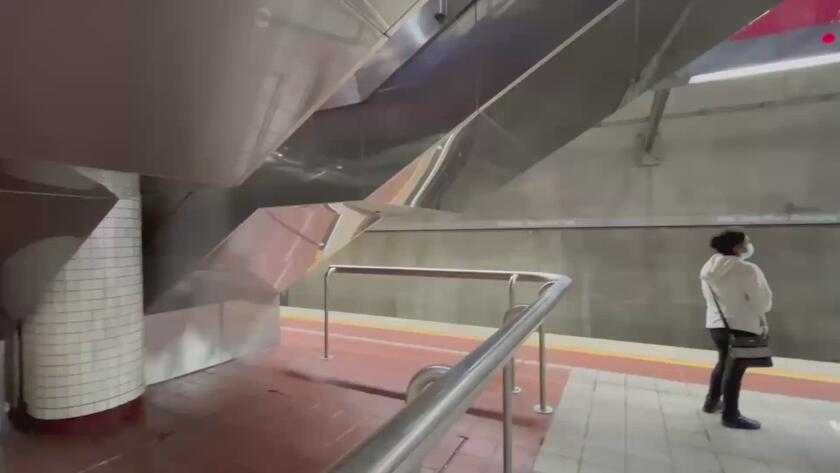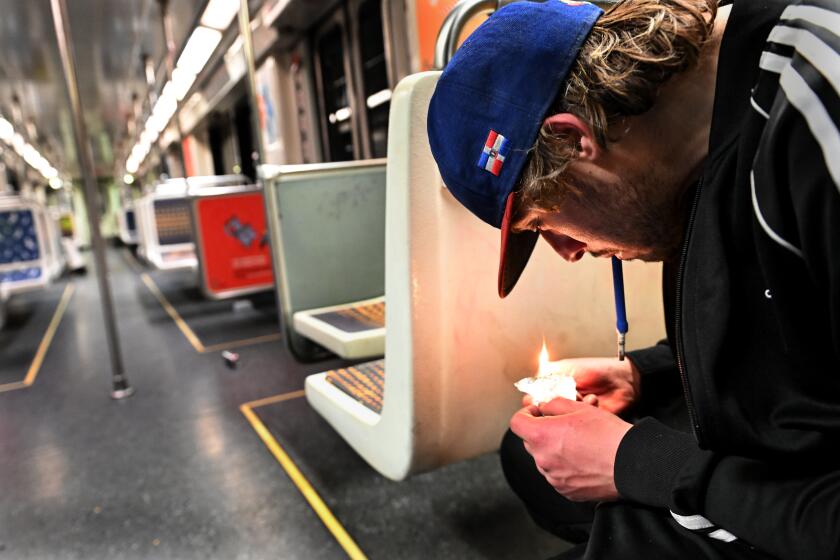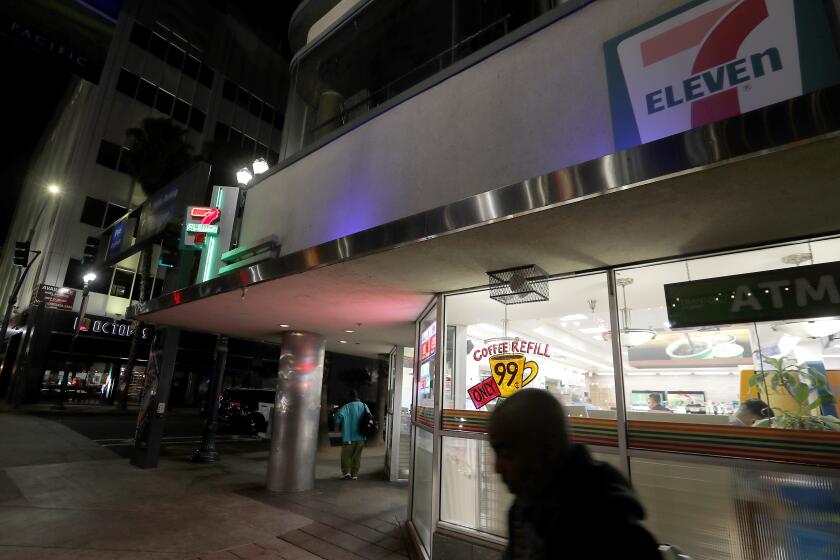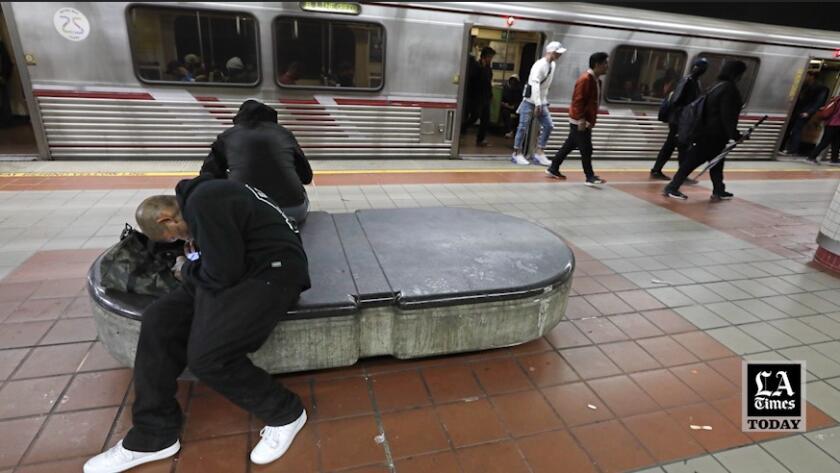L.A. blasting classical music to drive unhoused people from subway station. It’s louder than officials claim

- Share via
A battle is being waged at the Westlake/MacArthur Park Metro station near downtown Los Angeles. The weapon of choice? Loud classical music.
The classical music — along with floodlights at either end of the station platform — are part of a pilot program that L.A. Metro operations and security, in cooperation with law enforcement, began implementing at the station in January. In an email to The Times, Metro said the music is a royalty-free playlist it compiled of piano sonatas, symphony orchestra pieces and concertos, including some by Vivaldi, Beethoven and Mozart.
L.A. Metro’s goal with the music and lights is to reduce crime and drive away unhoused people. But the use of music is divisive, with online commentators calling it an inhumane torture tactic. Critics also argue that it does nothing to address the root causes of the problems plaguing the station.
Music, classical and otherwise, has a long history of being used as a technique for discomfort and coercion. Heavy metal and hard rock drove strongman Manuel Noriega out of hiding at the Vatican’s embassy in Panama City in 1989. The music of Metallica was used as a torture device against Iraqi detainees during the War on Terror and is listed on the notorious “Guantanamo Bay” playlist.
“You’re trying to attract and make certain people feel comfortable based on the associations with classical music,” says musicologist Lily E. Hirsch, author of “Music in American Crime Prevention and Punishment.” “And you see that in fancy cheese shops that play classical music because they hope people will feel like they’re a part of some elite upscale world and then they’ll spend more money.”
That feeling is not intrinsic to classical music, says Hirsch, but when the music is being used as a tool to achieve a goal — driving certain people away while welcoming others, for example — those cultural associations are manipulated.
When classical music is used in dark and aggressive ways, it can also feel dystopian and creepy, notes Hirsch, not unlike the mood of “The Silence of the Lambs.” One Twitter user compared the music at MacArthur Park station to Stanley Kubrick’s psychological horror film “A Clockwork Orange.”
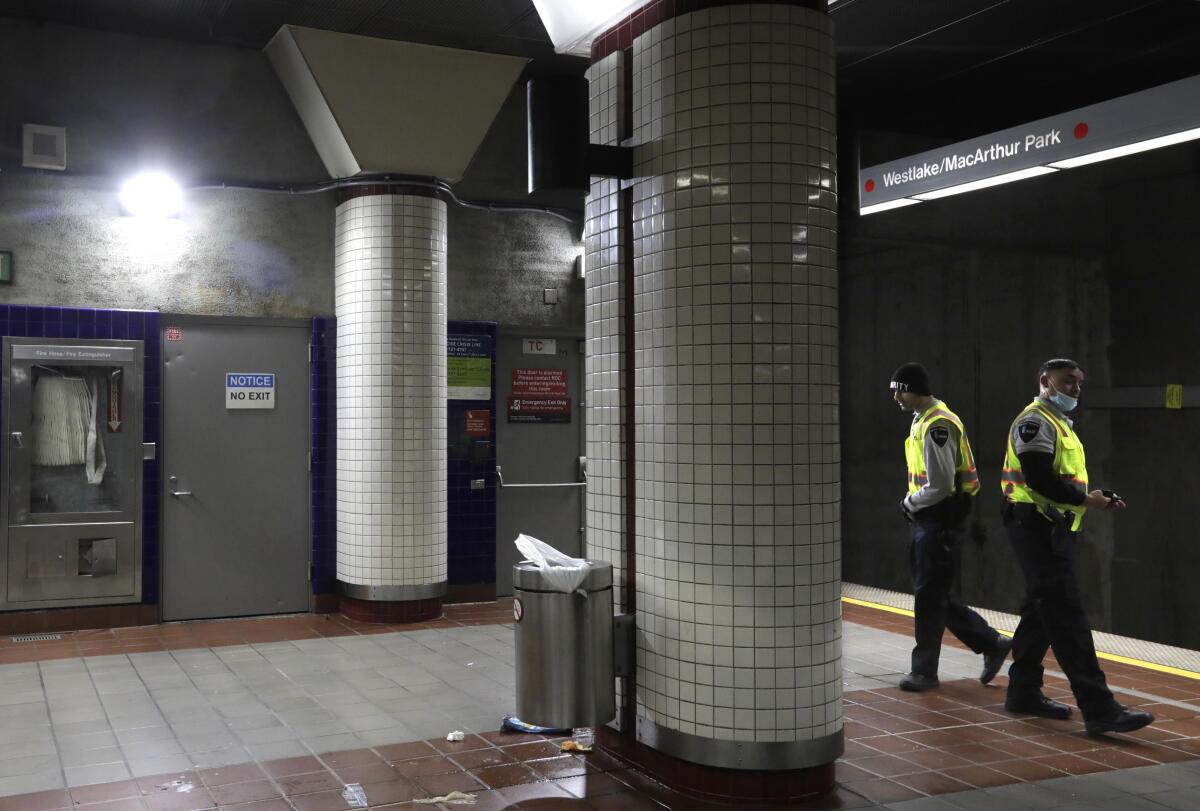
Sound is experienced differently in different environments, and it can be louder depending on where it is being heard. Decibels are the measure of sound intensity. In confined spaces such as a subway station, which has hard edges, high ceilings and plenty of echo-y metal and concrete surfaces for the sound to bounce off of, decibel levels will be higher.
The music in the Westlake/MacArthur Park Metro is not being played at fancy-cheese-shop levels: It clocks in at an average of 83 decibels on a handheld decibel meter, although during some string flourishes it peaks at 90 dB (depending on where in the station you’re standing, and your proximity to the speakers). The Centers for Disease Control and Prevention website puts decibel levels between 80 and 85 on par with gas-powered lawnmowers and leaf blowers, and notes that damage to hearing is possible after two hours of exposure.
Commuters have abandoned large swaths of a Los Angeles Metro train system plagued by crime and the scourge of drugs.
In an email to The Times, L.A. Metro spokesperson Dave Sotero wrote that “the music is not loud” at MacArthur Park, saying the compositions inside the station are being played at 72 dB.
A handheld meter registered certain musical phrases at 73 dB, but rarely — it was typically much louder than that. Sotero also said the music in the station is quieter than walking on the sidewalk outside the station, which he said exceeds 80 dB. A trip aboveground with a handheld dB meter found the ambient street noise — street vendors chatting, kids playing and laughing, buses whooshing by — hovering at an average of 72 dB.
There is a clear disconnect between what transit riders and the unhoused are experiencing in the subterranean confines of the station and L.A. Metro’s official line about the music’s volume.
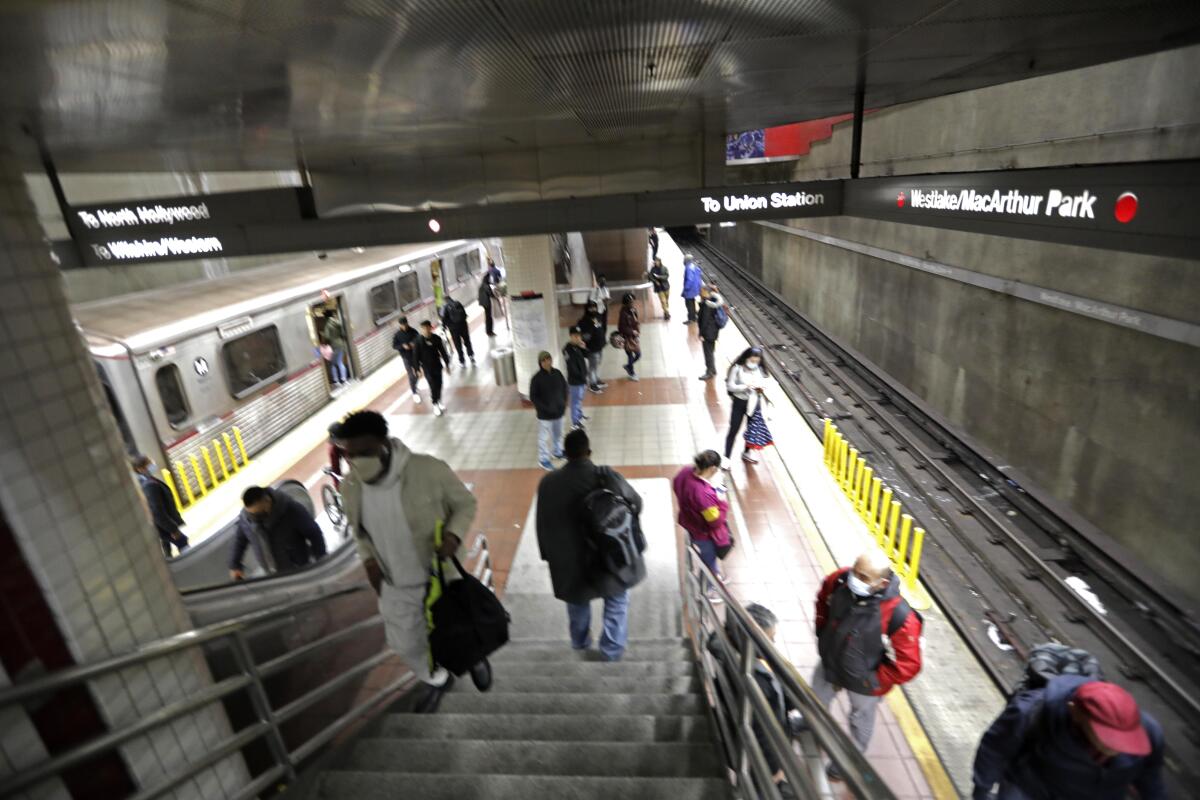
On a recent Monday afternoon in the station, commuters pace the sticky, trash-strewn platform, and a number of unhoused people rest on various concrete benches. A driving, high-energy piece of classical music blares, with ecstatic strings and many high notes punctuated by somewhat ominous low notes on keyboards. The four-minute composition “Immaterial,” by contemporary classical composer Adrián Berenguer, is being played on loop. (Berenguer did not respond to multiple requests for comment about this use of his music. It is unclear whether this song is royalty-free, as Metro stated.)
When two police officers approached two unhoused people and tried talking to them on Monday, one person cupped her hand to her ear. An officer leaned closer and shouted. The unhoused people nodded and began gathering their belongings to go, squinting in the bright spotlight.
It appears that the loud classical music is working at cross-purposes here, says Hirsch. She notes there is a history of classical music being used in public places, including town squares and outside various businesses, as a way to signal that certain people are wanted and others are unwanted.
“It’s like a bird marking its territory where you hear the signal and you go, ‘OK, this is not for me. This is for the older money crowd,’” she says. “And that technique seems to work. There are examples of teenagers leaving an area that’s playing classical music, not because they don’t like the music but because of the associations.” In fact, 7-Eleven has used classical music outside L.A.-area stores to deter loitering since 2019.
The problem with this approach, says Hirsch, “is you’re creating hierarchies of sound” by making it clear that an area belongs to certain privileged groups and not other people.
“And you’re not solving the problem,” she adds. “You’re just pushing the problem to another spot.”
The volume of the music at Westlake/MacArthur Park station makes it an outlier in this way, adds Hirsch, because the high decibel level intrinsically makes the station feel unwelcoming to anyone passing through. (One commuter said on Wednesday that the music was so loud that he might not continue riding Metro.)
Frustrated with homeless people loitering in their parking lots, the owners of several 7-Eleven franchises in Los Angeles have started installing speakers to blast a playlist of classical music all day and all night.
L.A. Metro is undoubtedly in crisis. A recent Times story reported that 22 people have died of suspected overdoses on Metro buses and trains so far this year, and that serious crime — including rape, aggravated assault and robbery — was up 24% for 2022 compared with 2021. A Times 404 video noted that Metro spends between $150 million and $200 million annually on policing, but a majority of emergency calls weren’t answered by law enforcement assigned to Metro.
In an email to The Times, Sotero wrote that the music is being used “to restore safety at the transit station” and “as means to support an atmosphere appropriate for spending short periods of time for transit customers who wait an average of 5 to 10 minutes for the next train to arrive.” The transit authority says the strategy has resulted in an “improvement in public safety,” citing a “75 percent reduction in calls for emergency service, an over 50 percent reduction in vandalism, graffiti and cleanups, and a nearly 20 percent drop in crime.”
Los Angeles County Supervisor Hilda Solis, who is also a Metro board member, issued a statement to The Times noting that she is working with the organization to introduce “care first” strategies to the station and plaza, and that she supports piloting safety interventions that “introduce alternatives to deploying additional armed law enforcement on the system.”
Yet the current alternative of elevated volume, coupled with repetition, is a way that music has been used as torture throughout history, says Hirsch. Constant exposure to loud music can disrupt sleep and thought and eventually make people lose their connection to themselves. In the 30 minutes a reporter spent in the station this week, the same piece of music was on loop — the same music was again playing on Wednesday when a Times photographer visited the station.
Isis Soto, an unhoused woman sitting in the station on a recent Wednesday, said she didn’t mind the loud orchestras and strings. “I enjoy classical music,” she says. “It wouldn’t keep me out. It will help keep me down here longer.”
Times photographer Genaro Molina contributed to this report.
- Share via
Watch L.A. Times Today at 7 p.m. on Spectrum News 1 on Channel 1 or live stream on the Spectrum News App. Palos Verdes Peninsula and Orange County viewers can watch on Cox Systems on channel 99.
More to Read
The biggest entertainment stories
Get our big stories about Hollywood, film, television, music, arts, culture and more right in your inbox as soon as they publish.
You may occasionally receive promotional content from the Los Angeles Times.
